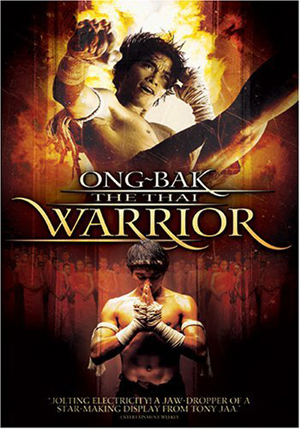
ONG BAK
Thailand, 2003, 105 minutes, Colour.
Tony Jaa.
Directed by Prachya Pinkaew.
London bus-side hoardings proclaimed, ‘Believe the hype’. Well, what is the hype?
After the martial arts balletics of Crouching Heroes of a Thousand Daggers, elegantly beautiful sagas, this is athletic martial arts (no strings attached). This is the tradition of the actual stunt work of Bruce Lee and Jackie Chan, Thai style. Hero Tony Jaa is worth watching for his extraordinary and accurately split-second timing leaps and bounds… and more (rather than his stolid acting).
The plot? Well, it’s the old one of the young man of the village, where the head of the statue of Buddha has been stolen by Bangkok thugs before the feast of Ong Bak. He goes to the city to retrieve the head. He finds himself in a world of drug dealers and drug lords and the brutal world of fight club. It does need a team of screenwriters to know that he will (reluctantly) fight the toughest champions and win, will be involved in all kinds of chases through alleyways and on highways, will confront the villains for a death-defying rescue of the head of Buddha, will be helped by a con-cousin who will repent and the cousin’s girlfriend who will end up in the village religious procession and that he will be the village hero. He does.
There is also a lot of headbutting, bonecrunching and bodypunishment in the fights that are not for the squeamish (or for the less than squeamish for that matter) but which will delight boxing and wrestling fans like those we see who spend their lives betting and screaming for bouts and knockouts in the club.
The film has been edited for western consumption by Luc Besson’s company and a different soundtrack added. Of course, it is all rather comic strip in style and we are meant to smile as the hero does the anticipated things. So, a mixture of the brutal, the heroic and the comic.
1.The impact of the film? Tony Jaa’s presence, athleticism, fighting skills? The niche audience and their immediate response?
2.The Thai settings, the village, the contrast with the city? The squalor of the city, the streets, the dwellings, the clubs? The musical score?
3.The basic plot: life in the village, the young boxer, the elders, the loss of the statue’s head, going to the city, lost in the city, having to fight to survive, the various fights to regain the head? Achievement? Basic plot?
4.The importance of the fighting sequences? The whole film being fight with touches of plot? The athleticism of Tony Jaa? His skills, moves? Traditional fighting skills, developing them? Various Thai traditions, body weapons?
5.The particular fights, in the village, in the city, in the clubs, in the cave? Clubs and tournaments?
6.The supporting characters, credible enough for this kind of plot? As foils for Tony Jaa?
7.The worldwide and immediate popularity of this film amongst martial arts devotees? The reasons for such an immediate impact?